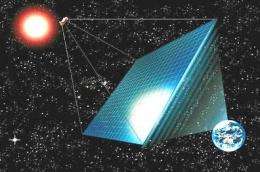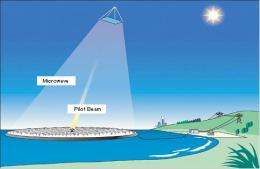September 15, 2009 weblog
$21 Billion Orbiting Solar Array will Beam Electricity to Earth

(PhysOrg.com) -- The Japanese are preparing to develop a two trillion yen (approximately $21 billion USD) space solar project that will beam electricity from space in the form of microwaves or lasers to around 300,000 homes in Japan within three decades.
The project, to be undertaken by a research group from 16 companies including Mitsubishi Heavy Industries Ltd, aims to spend the next four years developing the technology needed to beam the electricity produced to earth. They expect that as fossil fuels run out, an orbiting solar power plant in space may be needed to provide a significant source of electricity in the future, according to the Kensuke Kanekiyo, from the Japanese Government's Institute of Energy Economics.
The planned solar station will produce 1 Gigawatt of electricity from its four km2 (approximately 2.5 square miles) array of solar panels, which is enough to power just under 300,000 Tokyo homes, at present usage levels. Since the array will be in orbit some 36,000 km (22,500 miles) above the earth's surface, it will be unaffected by weather conditions and will be able to generate power constantly.
The U.S. agency NASA has been investigating the possibilities of a space-based solar system for several decades and has spent around $80 million on the research. They and other government agencies estimate the cost of electricity supplied from an orbiting solar array could be around $1 billion per megawatt, which is too expensive to be commercially viable.

The Japanese realize the cost of building the solar station in orbit would be prohibitive at the moment, and the array could not be commercially viable at today's prices. The Japanese consortium therefore has to find ways of drastically reducing the costs. With the launch of a single rocket costing around 10 billion yen, the cost of the space solar station could be as high as two trillion yen, according to Koji Umehara, the Director of the Japanese Space Development and Utilization ministry, making the electricity supplied exorbitantly expensive.
The first step in bringing the plans to fruition will be the launch in around 2015 of a satellite fitted with solar panels that will beam electricity to earth.
JAXA, the Japan Aerospace Exploration Agency plans to have the orbiting space solar system operational some time in the 2030s.
More information: www.usef.or.jp/english/f3_proj … ct/ssps/f3_ssps.html
© 2009 PhysOrg.com

















